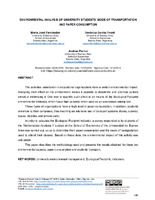| dc.rights.license | Licencia de Creative Commons Reconocimiento-NoComercial-CompartirIgual 4.0 Internacional (CC BY-NC-SA 4.0) | |
| dc.creator | Fernández, María José | |
| dc.creator | García Fronti, Verónica | |
| dc.creator | Parma, Andrea | |
| dc.date.accessioned | 2020-07-13T18:18:50Z | |
| dc.date.available | 2020-07-13T18:18:50Z | |
| dc.date.issued | 2020-07-01 | |
| dc.identifier.citation | Fernández, M. J., García Fronti, V., y Parma, A. (2020). Environmental analysis of university students’ mode of transportation and paper consumption. Visión de Futuro, Revista Científica. Posadas (Misiones): UNaM. FCE. PPA; 24(2), 146-165. | |
| dc.identifier.issn | 1668-8708 | |
| dc.identifier.other | VF-052 | |
| dc.identifier.uri | https://hdl.handle.net/20.500.12219/2528 | |
| dc.identifier.uri | https://doi.org/10.36995/j.visiondefuturo.2020.24.02.004.en | |
| dc.identifier.uri | https://visiondefuturo.fce.unam.edu.ar/index.php/visiondefuturo/article/view/412/298 | |
| dc.description | Fil: Fernández, María José. University of Buenos Aires. School of Economics; Argentina. | en |
| dc.description | Fil: García Fronti, Verónica. University of Buenos Aires. School of Economics; Argentina. | en |
| dc.description | Fil: Parma, Andrea. University of Buenos Aires. School of Economics; Argentina. | en |
| dc.description.abstract | The activities undertaken in educational organizations have a certain environmental impact. Analyzing their effect on the environment makes it possible to determine and prioritize actions aimed at minimizing it. One way to quantify such effect is by means of the Ecological Footprint environmental indicator, which has a high potential when used as an awareness-raising tool.
These types of organizations have a high level of paper consumption. In addition, students commute to their campuses, thus involving an intensive use of transport systems (trains, subway, buses, bicycles, and private cars).
In order to calculate the Ecological Footprint indicator, a survey responded to by students of the ‘Mathematical Analysis II’ subject at the School of Economics of the Universidad de Buenos Aires was carried out, so as to determine their paper consumption and the mode of transportation used to attend their classes. Based on these data, the environmental impact of this activity was calculated.
This paper describes the methodology used and presents the results obtained for these two environmental aspects: paper consumption and students’ transport. | en |
| dc.format | application/pdf | |
| dc.language.iso | eng | en |
| dc.publisher | Universidad Nacional de Misiones. Facultad de Ciencias Económicas. Programa de Posgrado en Administración | es_AR |
| dc.rights.uri | http://creativecommons.org/licenses/by-nc-sa/4.0/ | |
| dc.source | Visión de Futuro (Misiones), 7-2020; 24(2): pp. 146-165 https://visiondefuturo.fce.unam.edu.ar/index.php/visiondefuturo/index | |
| dc.subject | University environmental management | en |
| dc.subject | Ecological Footprint | en |
| dc.subject | Indicators | en |
| dc.title | Environmental analysis of university students’ mode of transportation and paper consumption | en |
| dc.type | info:eu-repo/semantics/article | |
| dc.type | info:ar-repo/semantics/artículo | |
| dc.type | info:eu-repo/semantics/publishedVersion | |




